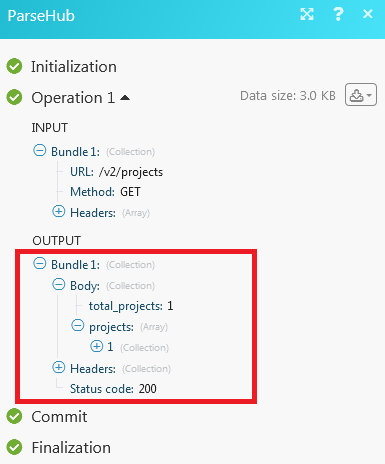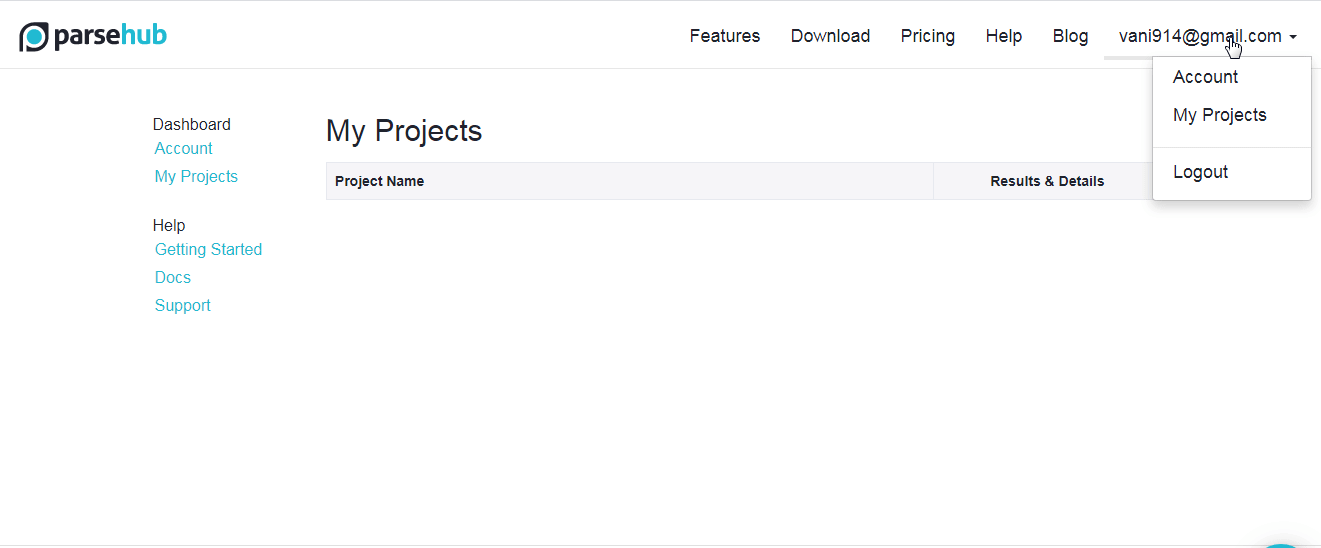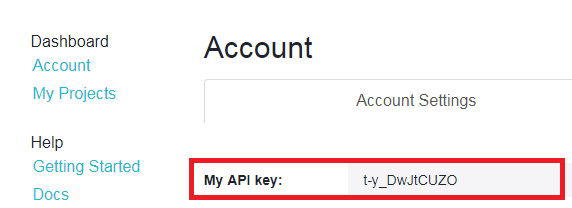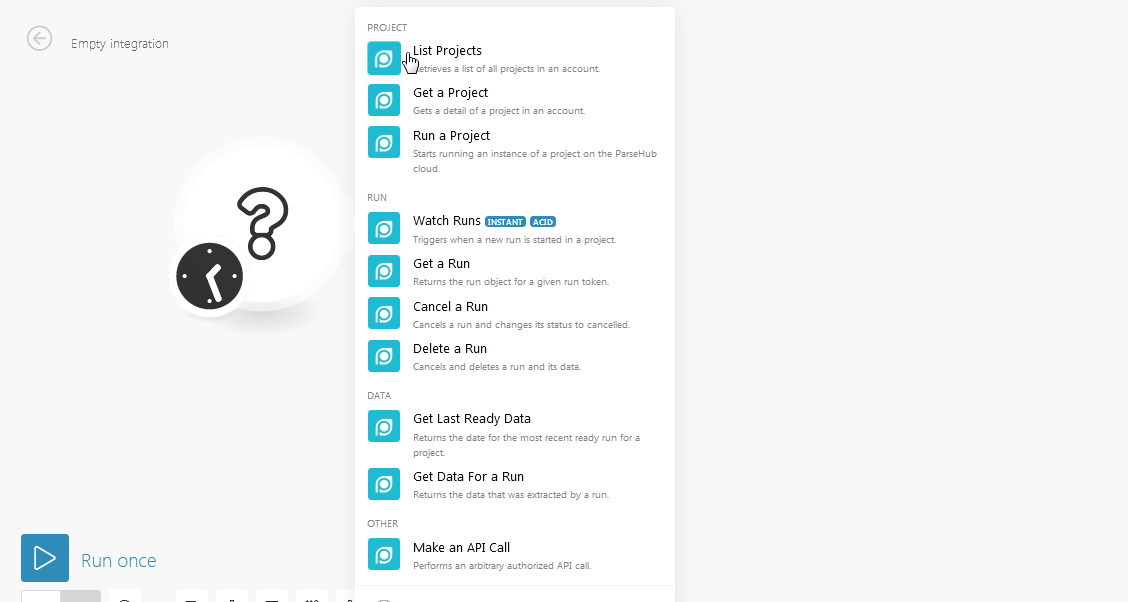| Active with remarks |
|---|
| This application needs additional settings. Please follow the documentation below to create your own connectionUnique, active service acces point to a network. There are different types of connections (API key, Oauth…). More. |
The ParseHub modulesThe module is an application or tool within the Boost.space system. The entire system is built on this concept of modularity. (module - Contacts) More allow you to create, update, list, and/or delete projects, runs, and get data in your ParseHub account.
Prerequisites
-
A ParseHub account
In order to use ParseHub with Boost.spaceCentralization and synchronization platform, where you can organize and manage your data. More IntegratorPart of the Boost.space system, where you can create your connections and automate your processes. More, it is necessary to have a ParseHub account. If you do not have one, you can create a ParseHub account at https://www.parsehub.com/.
![[Note]](https://docs.boost.space/wp-content/themes/bsdocs/docs-parser/HTML/css/image/note.png) |
Note |
|---|---|
|
The moduleThe module is an application or tool within the Boost.space system. The entire system is built on this concept of modularity. (module - Contacts) More dialog fields that are displayed in bold (in the Boost.space Integrator scenarioA specific connection between applications in which data can be transferred. Two types of scenarios: active/inactive. More, not in this documentation article) are mandatory! |
To connect your ParseHub account to Boost.space Integrator, you need to obtain your API Key.
-
Log into your ParseHub account.
-
Click your profile icon and click Account.
-
Copy the API Key to your clipboard.
-
Go to Boost.space Integrator and open the ParseHub module’s Create a connection dialog.
-
In the Connection Name field, enter a name for the connection.
-
In the API Key field, enter the API Key copied in step 2.
-
Click Continue.
The connection has been established.
Retrieves a list of all projects in an account.
|
Connection |
|
|
Limit |
The maximum number of projects Boost.space Integrator should return during one scenario execution cycleA cycle is the operation and commit/rollback phases of scenario execution. A scenario may have one or more cycles (one is the default).. |
Gets details of a project in an account.
Starts running an instance of a project on the ParseHub cloud.
|
Connection |
|
|
Project token |
The maximum number of projects Boost.space Integrator should return during one scenario execution cycle. |
|
Start value override |
Enter the value with which you want to override the start value of the run for this project. |
|
Send email |
Select if you want to send notifications about this project. |
TriggersEvery scenario has a trigger, an event that starts your scenario. A scenario must have a trigger. There can only be one trigger for each scenario. When you create a new scenario, the first module you choose is your trigger for that scenario. Create a trigger by clicking on the empty module of a newly created scenario or moving the... when a new run is started in a project.
|
Connection |
Returns the run object for a given run token.
|
Connection |
|
|
Run token |
Enter the unique Run ID of the data you want to retrieve. |
Cancels a run and changes its statusCreate statuses for each module separately to create an ideal environment for efficient and consistent work. More to canceled.
|
Connection |
|
|
Run token |
Enter the unique Run ID you want to cancel. |
Cancels and deletes a run and its data.
|
Connection |
|
|
Run token |
Enter the unique Run ID you want to delete. |
Returns the date for the most recent ready run of a project.
![[Note]](https://docs.boost.space/wp-content/themes/bsdocs/docs-parser/HTML/css/image/note.png) |
Note |
|---|---|
|
Returned GZ archive file can be further extracted and downloaded using the CloudConvert > Convert a File module. |
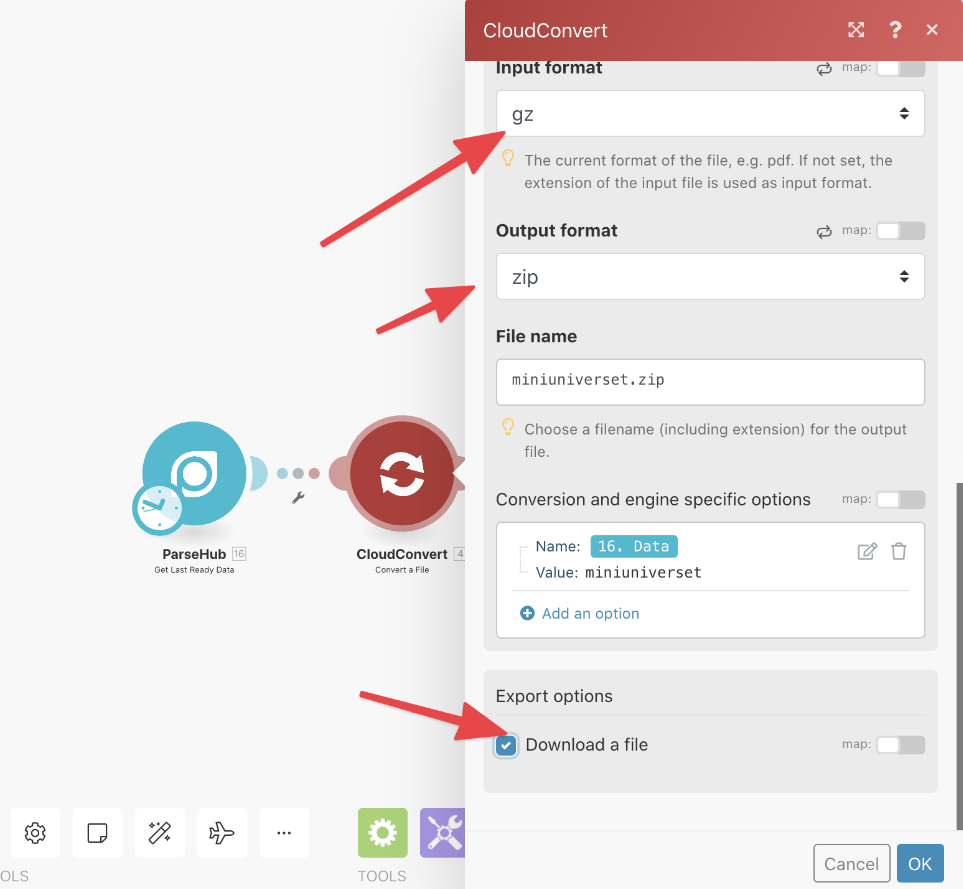
|
Connection |
|
|
Project token |
Select the project whose data you want to retrieve. |
|
Format |
Select the format in which you want to retrieve the details of the last ready data:
|
Returns the data that was extracted by a run.
|
Connection |
|
|
Run token |
Enter the unique Run ID whose data you want to retrieve. |
|
Format |
Select the format in which you want to retrieve the details of the last ready data:
|
Performs an arbitrary authorized API call.
|
Connection |
||||
|
URL |
Enter a path relative to
|
|||
|
Method |
Select the HTTP method you want to use: GET to retrieve information for an entry. POST to create a new entry. PUT to update/replace an existing entry. PATCH to make a partial entry update. DELETE to delete an entry. |
|||
|
Headers |
Enter the desired request headers. You don’t have to add authorization headers; we already did that for you. |
|||
|
Query string |
Enter the request query string. |
|||
|
Body |
Enter the body content for your API call. |
The following API call returns all projects:
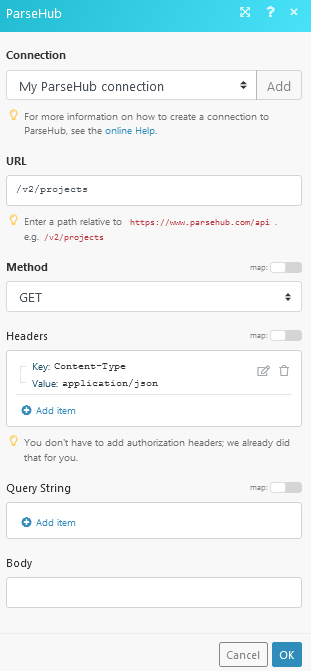
Matches of the search can be found in the module’s Output under BundleA bundle is a chunk of data and the basic unit for use with modules. A bundle consists of items, similar to how a bag may contain separate, individual items. More > Body > Projects.
In our example, 1 project is returned:
